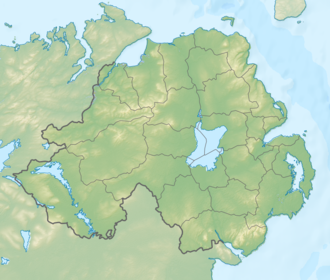| Annalong Forest | |
|---|---|
 Annalong Wood with the Mourne Mountains in the background | |
| Map | |
| Geography | |
| Location | Down,Northern Ireland,United Kingdom |
| Coordinates | 54°08′38″N5°56′24″W / 54.144°N 5.94°W |
| Area | 303.42 hectares (749.8 acres) |
| Administration | |
| Governing body | Northern Ireland Water |
Annalong Forest is located near the village of Annalong in County Down, Northern Ireland. It is made up of two sections: Annalong Wood and Silent Valley. The forest consists of various species of conifer. It is part of the Mourne Area of Outstanding Natural Beauty. It has been the site of two major fires, in 2010 and 2011.
